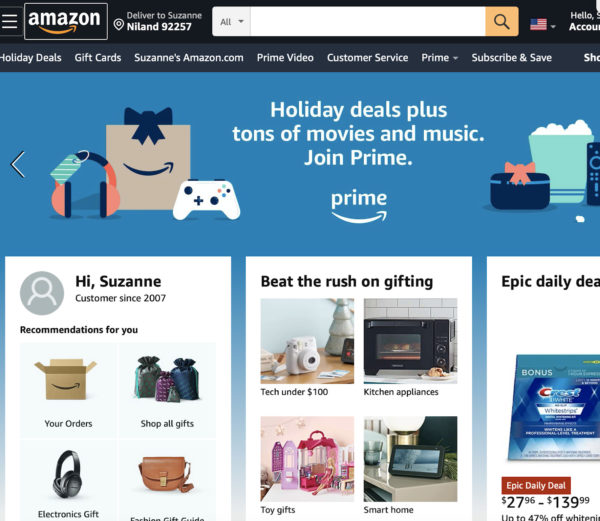
Your customers are all unique individuals at different stages of the buying process, and your outreach efforts should take this into account. To send effective messages to your different customer groups, you’ll need to leverage email segmentation. This process allows you to refine your messaging and images for the unique needs of your target audiences.
With email segmentation for ecommerce sites, you can divide your email list into different groups, or segments. You’re able to tailor your messages to fit each group, giving each person a clear reason to open and engage with your email.
Since segmentation means that fewer customers will receive unwanted or irrelevant emails from your organization, you limit your vulnerability to unsubscribes. What’s more, you give your future customers a reason to remember your brand. This plays into the “Rule of Seven,” which posits that people must see a brand an average of seven times before taking action and making a purchase.
There are plenty of other reasons why retail industry market segmentation is a growing trend. With market segmentation, you can:
- Stay more relevant to your different customers
- Communicate more effectively with people who appreciate your brand
- Reach out to potential customers to increase your online sales
Ready to take advantage of one of the most effective and accessible ways to target your buyers? Keep reading to learn more.
What is an email “segment”?
To get the basics out of the way, the definition of an email segment is simply separating out a part of your email list from the rest of it. This highly individualized process is your way of making sense of your email distribution list.
Think about all the people who have given you their email addresses. You likely talk differently to someone who is a long-time, loyal customer than to someone who only signed up to win a giveaway through social media. Those differences are the foundation of your messaging for each.
By avoiding content that simply doesn’t resonate with your audience, you’re less likely to have people hit the “unsubscribe” button. What’s more, you’ll be able to increase sales by increasing recipient interest and engagement with your brand.
What segments should you use for your retail business?
Some hypothetical segments have already been mentioned, and you’ve probably already thought of some groups that make sense for your ecommerce sales. Each segment requires a different message to be effective.
Loyal customers
Do you have people who regularly shop online with you? If so, they are your VIPs and you should communicate with them in a way that makes them feel as important as they are to your organization.
These people are your advocates. Give them reasons, like special discount codes, to share their opinions with their friends and family members. Let them know about new product launches before other customers. Cultivate this segment to keep them engaged and buying.
Customers with similar purchase histories
It doesn’t matter if you sell men’s designer clothing, books, or beauty products; there are some items that some people want and others definitely don’t. See if you can segment your email list into groups of people who have similar purchase histories so you can target them with special deals.
People with abandoned carts
Of course, you want to have the opportunity to politely remind someone who may have gotten distracted before completing the purchase. Make an email segment specifically targeting people with abandoned shopping carts. Make sure to update your lists when they do make a purchase.
Thankfully, most of these functions can be accomplished through email automation.
Geographic area
Perhaps it also makes sense to segment certain consumers by location. You may face variables on delivery costs or availability, and you want to make sure each group of current and potential customers have the most accurate information and offers.
Value-motivated consumers
Every retail business is different, but it’s safe to say that there are at least a few core values that you closely connect with your brand. If that’s the case, you can create an email segment for people who share your passion. If you have a petition or a way to get more information about a charity or an action-based campaign, you can capture email addresses and segment them easily.
How to get started on segmenting lists
Once you’ve prioritized the importance of gathering email addresses of your current and future customers, you will find that you’ve already accomplished the hard part. While you continue to grow your email list, don’t forget to keep breaking up your recipients into meaningful segments. This will save you work in the long run.
Start with an inventory of what you know
You may be surprised by the amount of information you can learn about a customer simply by taking inventory of their purchase history. Are they purchasing items for a certain type of job or hobby?
Once you have a clear understanding of your different target audiences, you’ll be able to more accurately divide your customers into different groups.

Ask them in a survey
If you’re not sure what type of customer a person may be, you don’t have to fret. You can simply ask them directly! A short, easy survey with the right questions can engage your customers while also telling you everything you need to know.
You can even provide an incentive, such as 5% off the next purchase, for filling out the survey.
Try click segmentation
Wondering how to reach people with abandoned shopping carts? What about potential customers that browse around but never add anything to their carts? There’s a method, and it’s called click segmentation.
The short version of this process is creating a well-thought-out sign-up form. You’re doing the work in advance so that the person filling out the form can segment themselves for you. You can give them a few options for what they’re most interested in or ask about their demographics. Find out why they’re signing up so you can directly meet that need.
Get step-by-step guides to help
If you’re on board with the theory but are still a little rattled about where exactly to begin the process of email segmentation, we’ve got you covered. Constant Contact has a step-by-step guide on segmentation that lays out the how-tos of optimizing your email list.
Any seasoned ecommerce business owner knows, however, that marketing doesn’t happen in a bubble. You can’t simply rely on direct email campaigns to grow your business. This process works best in collaboration with social media marketing, paid digital advertising, and a mobile-friendly, SEO-optimized website.




